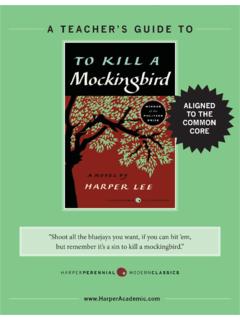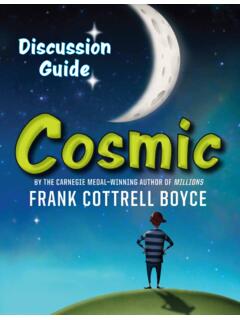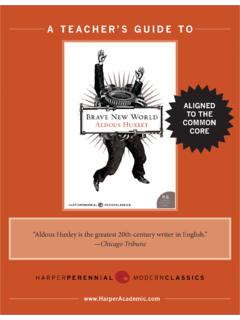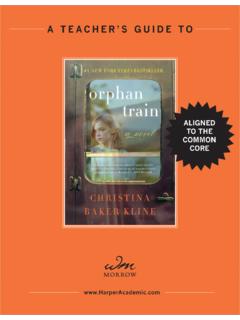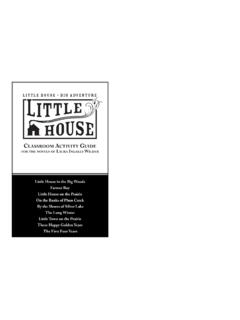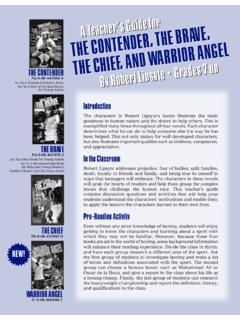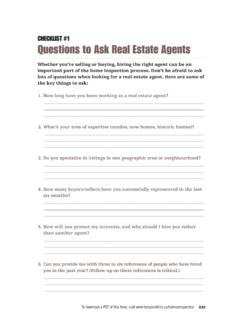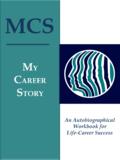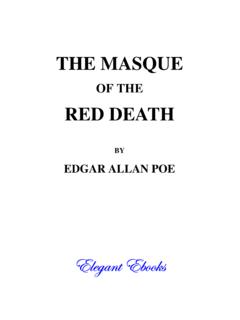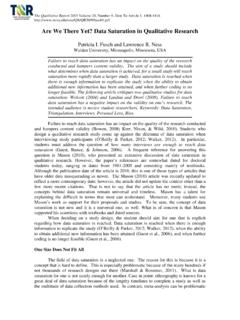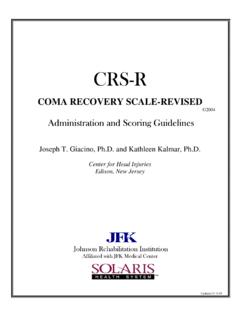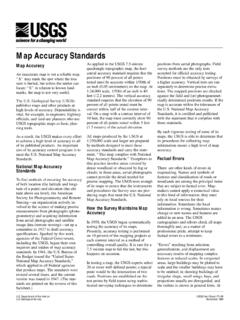Transcription of The World’s Bestselling Mystery
1 The world s Bestselling MysteryA TEACHER S GUIDE TOALIGNED TO THE COMMON A TEACHER S GUIDE TO AGATHA CHRISTIE S and then there were none 2 Table of ContentsNote to Teachers 3 Guided Reading Questions 4 Chapter 1 4 Chapter 2 4 Chapter 3 4 Chapter 4 5 Chapter 5 5 Chapter 6 6 Chapter 7 6 Chapter 8 6 Chapter 9 7 Chapter 10 7 Chapter 11 7 Chapter 12 8 Chapter 13 8 Chapter 14 8 Chapter 15 9 Chapter 16 9 Epilogue 9A manuscript document sent to Scotland Yard by the master of the Emma Jane fishing trawler 10 Writing and Discussion Prompts 11 Topics for Argumentation Essays or Debate 11 Topics for Informative Writing 12 Topics for Narrative Writing 13 Topics for Research Projects 14 Online Resources 15 Works by Agatha Christie 15 About This Guide s Author 18 Agatha Christie s and then there were none Character Observations Chart 19 A TEACHER S GUIDE TO AGATHA CHRISTIE S and then there were none 3 The questions and activities in this teaching guide were written to support standards-based instruction.
2 and then there were none meets the standard for Range of Reading and Level of Text Complexity for grade 8. Its structure, pacing, and universal appeal make it an appropriate reading choice for reluctant readers. The book also offers students an excellent opportunity to study the conventions of suspense and the murder Mystery genre. A complete list of the Common Core State Standards can be found at This Teacher s Guide is divided into three sections. The first, Guided Reading Questions, will help students with reading com-prehension and appreciation. These questions can be used as a guide for annotating the text, journal responses, or discussion. Many of these questions ask students to examine how clues about characters serve to drive the plot of the Mystery forward. In addition to answering these questions, students may find that filling out the Character Observations Chart that appears at the end of this guide will help them keep track of plot and character development in the book.
3 Second section, Writing and Discussion Prompts, consists of analytical writing and discussion prompts and is subdivided into genres based on the writing standards. The third section, Topics for Research Projects, requires students to conduct and synthesize significant outside research on topics related to the novel. to Teachers A TEACHER S GUIDE TO AGATHA CHRISTIE S and then there were none 4 CHAPTER 11. Based on your reading of the first chapter, how would you describe the way this book is narrated? Can you identify the point of view that the author uses? Why might the author have made the choice to narrate the book this way? Consider how the author introduces each of the eight characters in this chapter. Do you find yourself immediately liking any of the characters? If so, who and why? If not, why not? What important details do you find out about each character and his or her situation?
4 Cite evidence from the text to support your readings of the characters. (Hint: Use your Character Observa-tions Chart to help you keep track of characters.) Several of the characters know a little bit about Soldier Island, though no one seems to know much. Locate passages that provide you with clues about the history and environment of Soldier Island. Who invites these eight characters to Soldier Island? 21. How much do the guests of Soldier Island seem to know about the person or people who invited them to stay? What parts of the text show the relationship between the guests and the host or hosts of the island? On page 27, the text notes that Anthony Marston looks like a young God, a Hero God out of some Northern Saga. In con-crete terms, what does this suggest about his features? (For example, what color hair do you think he has? About how old do you think he is?)
5 How do the other characters in the book react to their first glimpses of Marston? Who is Fred Narracott, and what observations does he make about the guests? ; Describe the house on Soldier Island. What does it look like? How are the eight guests greeted once they arrive at the house? What important information do they find out about their host or hosts once they arrive? Who are Mr. and Mrs. Rogers and how are they characterized? Point to specific moments in the text to support your answer. What is the connection between Soldier Island and the poem that s displayed in Vera Claythorne s bedroom? Why do you think the author chose to include this poem in the novel? Chapter 2 offers a few more clues about the novel s characters and their pasts. What characters do we find out the most about? What specific passages provide details that throw suspicion on these individuals?
6 31. What is the significance of the ten soldier figures displayed on the dining room table? What predictions can you make about these figures? What do Vera Claythorne and Emily Brent discuss in the drawing room after dinner? What does each woman find out about the other? What does the gramophone announcement suggest? Who is responsible for playing the gramophone announcement? What are the immediate effects of the gramophone announcement on the guests? Compare and contrast how the guests of Soldier Island interact with one another before and after the gramophone announcement. Reading Questions A TEACHER S GUIDE TO AGATHA CHRISTIE S and then there were none 55. On page 53, Philip Lombard points out that the gramophone record is titled Swan Song. What is a swan song ? Why do you think the record is titled Swan Song? In comparing invitations to the island, what do the guests discover?
7 Who takes the lead as the group begins to share their stories about being invited to the island? What important discovery is made about the name of the person who invited each guest to the island? Which guests are portrayed as dishonest in this chapter? Cite specific evidence from the text to support your answer. 41. With the exception of Emily Brent, each character provides more information about the accusations made by the voice on the gramophone. What do you find out about each character s connection to a past death in this chapter? What does Armstrong recall about the Seton case that Judge Wargrave adjudicated? How does Vera Claythorne s story provide you with more information about her character and connect to previous moments in the book? Which characters take full responsibility for the deaths they ve been accused of being responsible for? Which of these charac-ters seem remorseful about the parts they played in the deaths?
8 The judge suggests that all of the guests should leave the island immediately. What is the problem with this course of action? Who dies at the end of the chapter, and how does he die? 51. Why does Dr. Armstrong examine Marston s drink? What does he discover? What do the guests conclude about Marston s death? Consider the description of the house that occurs on page 79. What does this description tell us? How do the passages that focus on Judge Margrave, General Macarthur, and Vera Claythorne alter your perceptions of these characters? Cite specific details from the text to support your answer. In what ways might the last lines of each section in this chapter foreshadow future events in the story? What happens to the ten soldier figures on the dining room table? How do these figures connect to the poem and the events that have so far taken place in the novel?
9 Based on this, make a prediction about what is likely to happen in the rest of the novel. Examine the author s use of italics, ellipses, and dashes. When do you see the author making these formatting choices? Why does she make them? A TEACHER S GUIDE TO AGATHA CHRISTIE S and then there were none 6 CHAPTER 61. When Mrs. Rogers dies mysteriously in the night, what is the possible cause of her death according to Dr. Armstrong? Emily Brent? Blore? What are the guests waiting for? What complicates the arrival of what they are waiting for? What does General Macarthur say about the guests stay on the island? At the end of the chapter, what does Rogers observe about the arrangement of the dining room? 71. While sitting with Vera Claythorne, what does Emily Brent reveal about the accusations that were made about her by the voice on the gramophone? What is Miss Brent s reaction to the accusations made about the other guests?
10 What is Vera s re-sponse to Miss Brent? In talking with Armstrong, why does Lombard say, I mean it explains Soldier (114)? What is explained about the island in this conversation? What do Armstrong and Lombard decide about the two deaths that have taken place? How are these deaths connected, ac-cording to the theory that Armstrong offers? What do Armstrong and Lombard decide to do in light of the events that have taken place? 81. On page 121, Blore suggests that Mr. Owen has decided to do the job by proxy. What does by proxy mean? What is Blore suggesting? ; What do Blore and Armstrong discover Lombard has brought with him to the island? What is Lombard s explanation for bringing this item? In searching the island, what exactly are Blore, Armstrong, and Lombard looking for? What are the results of their search? During this search, what do they conclude about their chances of getting off the island?

